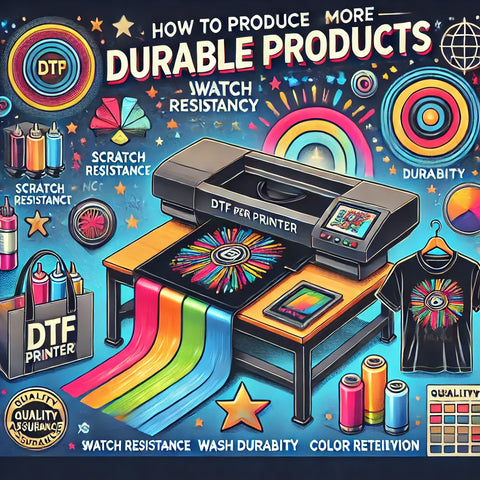If you're in the custom apparel and printed products industry, ensuring print durability is crucial for customer satisfaction and brand reputation. No one wants a design that cracks, fades, or peels after a few washes.
This is where DTF (Direct-to-Film) transfer printing comes in. Unlike traditional methods, DTF prints are more flexible, vibrant, and long-lasting, making them perfect for high-quality, durable printed products.
So, how can you maximize durability with DTF transfer printing? Here’s a detailed guide to help you produce longer-lasting, professional-grade prints. 🚀
1. Why Choose DTF Transfer Printing for Durability?
✔ Why It Matters:
DTF printing is one of the most durable and versatile printing methods available today.
✔ Key Advantages of DTF Printing:
✅ Superior Adhesion – Transfers bond deeply with fabric fibers, reducing peeling.
✅ Vibrant & Fade-Resistant Colors – High-opacity inks retain brightness even after multiple washes.
✅ Flexible & Stretchable Prints – DTF designs stretch without cracking, making them perfect for activewear and sportswear.
✅ Compatible with Multiple Fabrics – Works on cotton, polyester, blends, denim, and more.
📌 Pro Tip: If you're looking for long-lasting designs, DTF printing offers a more durable alternative to screen printing and DTG.
🚀 Example: A DTF-printed hoodie will maintain color vibrancy and fabric softness after dozens of washes.
2. Use High-Quality DTF Film & Ink for Longevity
✔ Why It Matters:
The quality of DTF film and ink directly affects the durability and finish of your prints.
✔ Best Practices for Long-Lasting Prints:
✅ Choose premium PET transfer film – Thicker films hold more ink, leading to better adhesion.
✅ Use high-opacity, stretch-resistant inks – Ensures bold colors without cracking.
✅ Store ink and film properly – Keep away from moisture and direct sunlight to prevent degradation.
📌 Pro Tip: Always check your DTF film compatibility with your printer and heat press settings for optimal results.
🚀 Example: A sportswear brand using high-quality DTF inks ensures designs remain intact after intense workouts and washing cycles.
3. Optimize Heat Press Settings for Maximum Durability
✔ Why It Matters:
Incorrect heat press settings can lead to poor adhesion, causing peeling and early fading.
✔ How to Improve DTF Transfer Durability:
✅ Set the correct temperature – Most DTF prints require 160-180°C (320-356°F).
✅ Apply even pressure – Use medium to firm pressure to ensure complete transfer.
✅ Follow proper curing times – Press for 10-15 seconds to fuse ink into the fabric.
📌 Pro Tip: Always test press on sample fabrics before full production to ensure optimal heat settings.
🚀 Example: A custom merch store adjusts their press settings for different fabrics, ensuring consistent durability across all products.
4. Choose the Right Fabric for Longevity
✔ Why It Matters:
Certain fabrics hold prints better, ensuring longer-lasting designs.
✔ Best Fabrics for DTF Transfers:
✅ 100% Cotton – Great for casual wear and everyday use.
✅ Polyester & Blends – Ideal for sportswear, activewear, and performance clothing.
✅ Denim & Canvas – Works well for bags, jackets, and heavy-duty prints.
📌 Pro Tip: Avoid cheap, loosely woven fabrics, as they absorb less ink and may cause early peeling.
🚀 Example: A streetwear brand printing on heavyweight cotton tees ensures long-lasting designs with a premium feel.
5. Follow Proper Post-Printing Care Instructions
✔ Why It Matters:
Educating your customers on proper washing and care helps maintain print quality.
✔ Best Care Instructions for DTF Prints:
✅ Wash inside out – Reduces friction and prevents fading.
✅ Use cold water & mild detergents – Harsh chemicals weaken ink adhesion.
✅ Avoid high heat drying – Use low heat or air dry to preserve print quality.
✅ Do not iron directly on the print – High heat can damage the design.
📌 Pro Tip: Include wash & care labels in product packaging to remind customers how to preserve their prints.
🚀 Example: A print-on-demand brand provides a care guide with each order, reducing customer complaints about fading.
6. Offer Quality Assurance to Build Customer Trust
✔ Why It Matters:
Customers trust brands that guarantee product durability.
✔ Ways to Ensure Quality Control:
✅ Test print samples – Check for adhesion, color vibrancy, and stretch resistance.
✅ Perform wash tests – Run prints through multiple wash cycles to check durability.
✅ Offer return & replacement policies – Build customer confidence by standing behind your products.
📌 Pro Tip: If you’re selling on platforms like Etsy or Shopify, highlight your print quality guarantees in product descriptions.
🚀 Example: A DTF printing business offers a 30-day fade-proof guarantee, leading to higher customer satisfaction and trust.
Final Thoughts: How to Make Your DTF Prints Last Longer
📌 Key Takeaways:
✔ Use premium DTF film & high-opacity inks to achieve bold, fade-resistant designs.
✔ Optimize heat press settings to ensure proper ink transfer and adhesion.
✔ Choose the right fabrics that hold prints well for long-lasting wear.
✔ Educate customers on washing & care instructions to maintain print quality.
✔ Implement quality control tests to ensure every print meets durability standards.
✔ Offer a durability guarantee to build trust and increase repeat customers.
🚀 Want to produce more durable printed products? Follow these DTF printing best practices and create long-lasting, high-quality designs that your customers will love!






